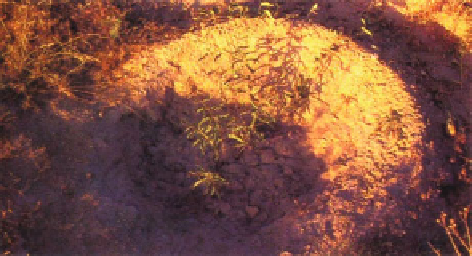Agriculture Reference
In-Depth Information
Fig. 6.1
Deep planting with
pit-saucer
refilled soil, and the pit should be filled up with the remaining soil or soil-manure
mix. Having filled the pit, the soil should be firmed in by treading over it. However,
the soil should not be rammed hard. Soil pores should remain open to some extent in
order to enable aeration and to maintain water holding capacity. In case of bare-root
plants, compaction of soil is of crucial importance since the soil must come in contact
with the roots of the plant immediately. This can also be facilitated by watering.
If advance planting is being carried out, the pit should be first filled with water,
water should be allowed to seep in, and then planting should be done. After planting,
at least 15-20 l of water per plant should be given. In post-rain planting, watering
should be done if more than a week has passed since the last rain, and if the soil is
light and no water is present at the bottom of the pit when planting is done. In sand
dunes, no watering is required in post-rain planting since water will not be retained
more than what is retained immediately after the rains.
The level of the plant collar should be kept at least 10 cm lower than the level
of the ground. This method of 'deep planting' (Fig.
6.1
) is preferable because more
water is stored in the pit and the saucer during rains. In almost all cases except saline
soils, deep planting should be the standard practice in arid and semiarid areas. In case
of waterlogged saline soils, however, mound planting should be practised, wherein
pit is refilled, a mound of soil is raised, and planting is carried out on that mound,
such that the collar of the plant is about 15-20 cm above the ground level.
Planting of bare-root (naked-root) seedlings is a simpler operation. The operation
is best carried out during a downpour, although advance planting can be done if
watering can be arranged. The roots of the seedling are inserted into the pre-dug pit,
or into the slit made with a sharp implement, and the latter is closed over by filling in
topsoil or the dug soil, followed by careful treading to ensure firm contact between
the soil and the roots. If watering is being done, or if it is raining while planting,
root-soil contact is assured and survival will be much better.
Sand dunes that are characterised by moving sand will not retain the shape of
the pit. Pit digging is thus not required. Sand is pulled aside with a spade to make
room for the plant, the polypot is removed, the plant is inserted into the depression
so made, and the depression is closed over again with sand. Soil should be firmed
in to make the plant upright and stable. In post-rain planting, moisture in the sand is
often adequate for a long time due to the absence of capillary action.

Search WWH ::

Custom Search